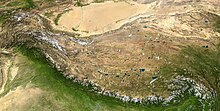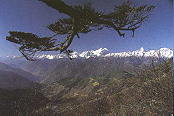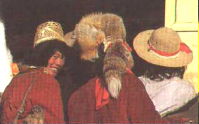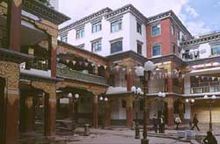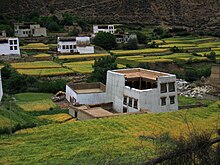Tibetan cultural area
The highlands of Tibet , which in its extreme south encompass a large part of the Himalayan mountains and extend at an average altitude of 4500 meters, are considered to be the " roof of the world ".
The high plateau of Tibet is desert-like , the driest part is the western part of the alpine steppes known as Changthang (Tibetan for "northern level (s)"). The main reason for the drought is that the Himalayas shield the highlands from the Indian monsoon rains to the south and that the interior has a continental climate .
Enclosed is Tibet from the mountains of the Himalayas to the south and west, the osttibetisch-Chinese border chains in the East (Min Shan, Minya Konka , Hengduan Mountains ), the Karakoram in the north-west and the Kunlun Shan to the north, but inside it is supported by numerous Mountain bars crisscrossed. Tibet borders from west to east on the Indian union territory of Ladakh and the Indian states of Himachal Pradesh , Uttarakhand , Sikkim and Assam (according to the Chinese view) and Arunachal Pradesh (according to the Indian view and current political borders) as well as the countries Nepal , Bhutan and Myanmar (Burma), with a total length of the border with these three countries of almost 4000 km.
The "geographical" Tibet (ie the highlands of Tibet including the peripheral mountains in China and neighboring countries) extends over an area of 2.5 million km² and is traditionally divided into the following cultural regions.
Central Tibet
| Tibetan name |
|---|
|
Tibetan script :
དབུས་ གཙང
|
|
Wylie transliteration : dbus gtsang
|
|
Official transcription of the PRCh : Ü-Zang
|
|
THDL transcription : |
|
Other spellings: U-Tsang
|
| Chinese name |
|
Traditional :
衛 藏
|
|
Simplified :
卫 藏
|
|
Pinyin : Wèi-Zàng
|
Due to its importance for the cultural history of Tibet, the suitcase word Ü-Tsang has become established in the country , while in the west the name Central Tibet has become established, even if these areas are geographically located in the south of the Tibetan highlands . In fact, in the last few centuries, Ü-Tsang usually meant more or less the domain of the Dalai Lamas , which had quite different dimensions, which is why the borders with the neighboring regions of Ngari in the west, the Changthang in the north, Lhokha (Tib; 'southern region ') were fluent in the south bordering the Himalayas and Kham in the east.
- Ü ( Tibetan དབུས DBUS = centers')
Ü is the old central cultural province with the capital Lhasa and, together with the Tsang province further west (based in Xigazê ), forms the cultural and historical heart of the highlands, which is therefore usually referred to as "Central Tibet" (Tib. Ü-Tsang ). Geographically, it is located in the south of the Tibetan highlands, while for centuries it has been the political, religious and economic center of the Dalai Lamas' domain . In the west it borders on the province of Tsang, in the north on the highland steppes of the Changthang, in the south bordering the Himalayas on Lhokha (= "southern region") and in the east on Kham.
- Tsang (Tib. གཙང gtsang )
Tsang , as one of the two main constituents of Ü-Tsang (Tib. དབུས གཙང dbus gtsang), is a landscape term that designates one of the two most historically important regions of Tibet: the old cultural province of Tsang with the capital Samzhubzê in western central Tibet.
Northern Tibet
| Tibetan name |
|---|
|
Tibetan script : བྱང་ ཐང
|
|
Wylie transliteration : byang thang
|
|
Official transcription of the PRCh : Qangtang
|
|
THDL transcription : Jangtang
|
|
Other spellings: Changtang, Changthang
|
| Chinese name |
|
Traditional : 羌塘
|
|
Simplified : 羌塘
|
|
Pinyin : Qiāngtáng
|
Changthang ( Tibetan བྱང་ ཐང ZWPY Qangtang , Wylie byang thang ) is the name of the extensive highland steppes in northwest Tibet ( China ). As alpine steppes, green grasslands predominate in summer, which in the dry winter half-year take on a desert-like character. Desert landscapes represent above all the high altitudes dominated by rock debris in the high mountains towering over the region as well as the much drier continental areas in the west of the Changthang. The mountain ranges of the Kunlun Shan are to be regarded as the northern and western borders , while the Changthang merges in the east into the steppe areas of the Yarmothang and into the landscapes of Amdo and Kham or Sichuan and Yunnan, which are shaped by the great East and Southeast Asian gorges .
This landscape extends to an average of 4500 meters above sea level and comprises predominantly alpine pastures, which are used exclusively by nomads , the drogpas (Tib. Brog pa ). Viewed from Lhasa and the cultural and historical central Tibet , they are in the north, which is why they are called "northern (byangs) plains (thang) ". With a maximum west-east extension of approx. 1500 km - from the Ladakhi Changthang in the west to the grasslands in Yushu (North Kham) and Golog (Amdo, both Qinghai ) - this often deserted alpine steppe region ultimately takes up more than half of the highlands of Tibet .
Framed by the high mountain ranges of the so-called Transhimalaya (actually Gangdisê and Nyainqêntanglha , but not the Himalaya) and the Kunlun Shan, the Changthang is a continental area with relatively little rainfall. Although mountain chains that rise up into the area of the eternal ice are repeatedly traversed, the Changthang gives the impression of endless expanse. Nevertheless, the landscape in the western and eastern parts is criss-crossed by large mountain ranges and river valleys, which is why the Changthang can be regarded as the region of origin for many of Asia's largest rivers. These include the Indus , Brahmaputra , Yellow River , Yangtze (with over 6000 km, the third longest river in the world), Salween and Mekong . The rivers in the interior of the Changthang flow into lakes with no outflow, the salinity of which is therefore usually very high and which feed the correspondingly pronounced marshland in their surroundings. The highest mountain of the central Changthang is the Zangser Kangri .
- climate
The Tibetan high plateau has an average altitude of 4100 m, which is why the climate in the highlands is bitterly cold, especially in winter. The climate is characterized by a high temperature difference between day and night and by rapid, strong weather changes. The average temperature in the Changtang varies, being warmer in the south and west than in the north and east. At Aru Co the average temperature is −8 degrees, in Shuanghu in the northeast it is −24 degrees Celsius. The annual temperature fluctuations are not as extreme as the daily ones. Temperatures in the west can drop from +20 to -40 degrees Celsius. In the northeast, in Shuanghu County, temperatures do not climb above freezing even in July. The average temperature is then around −10 degrees Celsius. Therefore the ground is frozen to a depth of 155 meters. Although there is little vegetation, no tree grows on an area of around 1 million km². Sometimes there are thinly overgrown sand dunes in Changthang , but highland swamps and cold deserts over large stretches. The aridity of inner Tibet is due to the continental situation, which is exacerbated by the fact that the more densely populated southern Tibet is shielded from the Indian monsoon by the Himalayas and the remaining moisture on the way to the Changthang also other mountain ranges (including the so-called. Transhimalaya) has to overcome.
- Flora and fauna
In the summer months, the grasslands in the wide and rough "plains" (actually high valleys) are used extensively by nomads as pastures for their sheep , goats and yaks .
The Changthang is a habitat for numerous wild animals that were once indigenous to large areas of Tibet and were pushed back (e.g. by expanding human habitat, but also by hunting, especially in the first seven decades of the 20th century). These include the Wildjak , the Kiang (Tibetan wild ass ), the Tibetan brown bear , the Tibetan Argali sheep as well as the blue sheep (Bharal), the Tibetan antelope ( Tschiru ) and the Tibetan gazelle .
- Changthang nature reserve
In 1983, in collaboration with American zoologists, China established the Changthang Nature Reserve - with 298,000 km² the largest nature reserve in Asia and the second largest in the world. Although poaching is still a problem, animal populations have increased significantly again. Black-necked cranes appear among the migratory birds in many places in the Changthang, which have also been placed under special protection.
Organizing the protection of the vast area is above all a question of cost. Area-wide surveillance is hardly possible with population densities of well below one person per square kilometer. One tries to win and train the local population as gamekeepers. Economic interests - the mineral deposits in the Changthang - offer another potential for conflict.
- economy
There are ore deposits that make the plateau generally economically interesting despite the adverse conditions. In addition, there is the production of salt through the many salt lakes . There are also isolated thermal springs . The gold digging, which has caused horrific ecological damage in many places, is being increasingly restricted by legal measures (bans by Chinese authorities), but is still not completely contained due to corruption (especially at the local level) and the difficult-to-control expanse of the area. In the last few years oil and gas deposits have been found in the Changthang, the controversial development of which is likely to be imminent.
Southern tibet
The southern Tibetan cultural area extends across borders to various countries in South Asia .
- Bhutan
- India
- Nepal
Tibetans or Tibetan-speaking groups can be found in all of these Tibetan cultural regions, although in the peripheral areas there are often other peoples who are not always linguistically related or culturally closely related to the Tibetans. For this reason, despite all the similarities, the Tibetan cultural area is also characterized by a certain cultural diversity.
Eastern Tibet
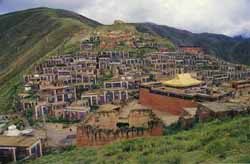
Eastern Tibet ( Dokham , Tibetan མདོ་ ཁམས་ , mdo khams ) is a frequently used, spatially but mostly not clearly defined term for the Eastern Tibetan cultural regions of Amdo and Kham , most of which belong to the provinces of Qinghai , Gansu , Sichuan and Yunnan . Since Tibet is comprehensively understood by many as the entire geographical highlands of Tibet , eastern Tibet appears more or less as the eastern part of Tibet, which is no more different from it. Indeed, the East Tibetan regions of Amdo and Kham can be distinguished to a large extent with their own cultural features, different population structures and a history that is highly independent, even if it is closely linked to central Tibet. Accordingly, the inhabitants of Eastern Tibet do not call themselves Böpa ( bod pa ), as the Tibetan term for Tibetans, but Amdowa ( a mdo pa ) and Khampa ( khams pa ).
During the Chinese Qing Dynasty , Amdo in 1724 and eastern Kham in 1728 were incorporated into the neighboring Chinese provinces .
Between 1911 and 1939, Kham was known as Chuanbian (川 邊 特別 區), and then changed its name to Xikang until 1955 . Amdo was administratively in Gansu Province of China from 1723 to 1927 and Qinghai Province from 1928 to now.
These areas did not belong to Tibet from 1911 to 1950, nor do they belong to the Tibet Autonomous Region today , but form Tibetan autonomous prefectures and counties within different provinces. The Tibetan government in exile is calling for the unification of all areas of the Tibetan cultural area.
Amdo
| Tibetan name |
|---|
|
Tibetan script : ཨ་ མདོ
|
|
Wylie transliteration : a mdo
|
|
Pronunciation in IPA : [
amto ]
|
|
Official transcription of the PRCh : Amdo
|
|
THDL transcription : Amdo
|
|
Other spellings: -
|
| Chinese name |
|
Traditional : 安 多
|
|
Simplified : 安 多
|
|
Pinyin : Ānduō
|
Amdo is a region northeast of Tibet that extends over the present-day Chinese provinces of Qinghai , Gansu and Sichuan . From a Tibetan point of view, it is regarded as one of the three historical provinces of Tibet , along with Kham and Dbus-Gtsang , but was never an administrative unit. Until the 19th century, the term did not appear individually, but in combination with Kham as Dokham ( mdo khams ) and referred to Eastern Tibet .
Geographically, Amdo von Kham stands out roughly outlined by the catchment area of the upper reaches of the Yellow River - with wide highland steppes in the west and southwest and arable valleys in the east and northeast, used by nomads. In the agricultural areas of Amdo, the Yellow River has created great canyon landscapes that have been used several times for large hydropower projects ( Longyang Xia , Liujia Xia , Lijia Xia ) and produce the electricity that has become one of the main export items of Qinghai Province .
To designate Amdo as a province is correct in the sense of a cultural province , the Tibetan cultural area of Amdos is also one of the most important and varied in the highlands of Tibet.
- history
From the 7th to the 9th centuries the Tibetan empire stretched from the Tarim Basin in the north, China in the east, India and Nepal in the south to the Kashmir region in the west. The newly won domains in the east and northeast were called Mdo-Khams . The A-mdo region comprised the north-eastern part of Tibet and reached from the upper reaches of the Huang He north-east to Mchod-rten dkarpo (today Gansu province in China). After 1270, the region was conquered by the Mongolian Yuan Dynasty and divided into several sub-areas, which came under the control of the Qing Dynasty in 1724 . After a Mongolian uprising was put down, Amdo was officially incorporated into the Chinese provincial system, and since 1928 most of it has belonged to Qinghai Province.
- population
Accordingly, the inhabitants of Amdo do not call themselves Böpa ( bod pa ), as the Tibetan term for Tibetans is, but Amdowa ( a mdo pa ). This regional name of the population nevertheless extends exclusively to groups speaking Tibetan dialects, which, apart from in the main valley between Xining and Lanzhou, make up the majority in Gansu (the Huang Shui river valley , Tib.Tsong Chu ) and neighboring regions as well as in and around a few other large cities . Other non-Han Chinese ethnic groups - in addition to the numerous Hui Muslims - Mongols , Monguor ( Tuzu ), Salaren , Bonan (Bao'an), Dongxiang and others. a. (see Qinghai and Gansu ). Accordingly, most of the administrative units under the provincial level have the designation "Tibetan" in their names: Tibetan Autonomous District / Prefecture (TAP) Golog , TAP, TAP Huangnan , TAP Hainan , etc.

- Monasteries
Famous monasteries in the region include a.
- Kumbum Champa Ling (Chinese Ta'er Si ) in Qinghai,
- Labrang Tashi Khyil in South Gansu ,
- Qutan Si (Gotamde), Youning Si (Rgolong), Rongwo Gönchen (Longwu Si) and
- Rakya Gompa in Qinghai,
- Dzamthang Chöde Chenpo , the main monastery of the Jonang Order in Dzamthang and the Buddhist monastery academy of Jigme Püntsog , Larung Gar , in Serthar (both in Sichuan ).
Very small monasteries can also be historically significant, such as Shadzong Ritrö , in which the later great Tibetan Buddhist reformer Tsongkhapa was consecrated by the 4th Karmapa at the age of three , and Shyachung Gompa (Jachung monastery, bya khyung ), where he began his monastic training Has.
In addition to the distinctive monastic culture, a large number of folk customs and cultural assets have been preserved or revived in Amdo, which are not so often seen in central Tibet. In particular, the lhatos , stone settings that are erected as an offering to the gods, with their lavish prayer flag decorations and oversized wooden arrows that are dedicated to the mountain gods, can be seen as a characteristic of Amdo.
Kham
| Tibetan name |
|---|
|
Tibetan script : ཁམས་
|
|
Wylie transliteration : khams
|
|
Pronunciation in IPA : [ came ]
|
|
Official transcription of the PRCh : Came
|
|
THDL transcription : Kham
|
|
Other spellings: -
|
| Chinese name |
|
Traditional : 西康
|
|
Simplified : 西康
|
|
Pinyin : Xīkāng
|
Kham is an east Tibetan region that extends partly over the east of what is now the Tibet Autonomous Region of the People's Republic of China and parts of the Chinese provinces of Qinghai , Sichuan and Yunnan . The region was called Xikang (西康省) during the rule of the Republic of China (1912–1949) , but it did not extend over the entire Kham. According to the common Western view, the People's Republic of China later divided Kham into other provinces . In fact, however, corresponding administrative structures had already emerged in the late imperial times of China ( Qing dynasty 1644–1911), the basis of which was not least the strong regional structure due to the political fragmentation of Kham.
According to the current political and administrative structure, Kham comprises 50 districts, of which 16 belong to Sichuan, three to Yunnan, six to Qinghai and 25 to the Tibet Autonomous Region . These are also part of a city and two administrative districts of the Tibet Autonomous Region ( Qamdo , Nagqu and Nyingchi ), two Sichuan autonomous districts ( Garzê and Ngawa ) and one each of Qinghai ( Yushu ) and Yunnan ( Dêqên ).
Kham is referred to as one of the three former provinces of Tibet ( cholka sum ) together with Amdo , but was never an administrative unit. Until the 19th century the term appeared separately, but often in combination with (A) mdo as Dokham ( mdo khams ) or, in the sense of this combination , is understood to represent Eastern Tibet as a whole. Politically and historically, Kham was a conglomerate of different independent rulers (Kingdoms of Derge , Nangchen and Poyül), Lama principalities (Dragyab, Riwoche, Muli) and partly from Lhasa (e.g. Pashö) or areas dependent on Chinese provinces.
Geographically, Kham stands out roughly outlined by Amdo through the catchment area of the upper reaches of the rivers Yangtzekang ( T. Dri Chu ), Mekong ( T. Dza Chu ), Salween ( T. Nag Chu / Ngül Chu ) and their tributaries - by, by Nomads used the highland steppes in the north and the high valleys or plains between the river valleys and gorges (the so-called sgangs ) as well as arable valleys that are mostly more densely populated along the tributaries of the main rivers.
- population
Accordingly, the inhabitants of Khams do not call themselves Böpa ( bod pa ), as the Tibetan term for Tibetans is, but Khampa ( khams pa ).
To call Kham a province is correct in the sense of a cultural province . This Tibetan cultural area of Khams is also one of the most important and varied in the Tibetan highlands. Famous monasteries and cultural centers are Jyekundo (Chin. Yushu ), the former Kingdom of De (r) ge (with the famous Dege Parkhang printing house ), Kandse, Litang, Qamdo (Chamdo) and Dragyab.
- history
From the collapse of the Tibetan royal family in the 10th century to the 1950s, the residents of Kham have maintained a high degree of independence from both Lhasa and Beijing . This was mainly possible due to the surface shape of the land. Kham was never ruled by a single king or lama prince, but there was always a large number of regional rulers, the most important of which was the Dege Gyalpo, "King of Dege ". After the conquest of Eastern Tibet around 1639/1640 (campaign against the king of Beri in Kham) and the subsequent submission of the kings of Tsang in 1641 by the Khoshuud- Mongolian prince Gushri Khan, who ruled in northern Amdo , he declared himself king of Tibet. Thus, for several centuries, the entire Tibetan settlement area was again subject to uniform, albeit Mongolian rule.
The special relationship between Gushri Khan and the 5th Dalai Lama Ngawang Lobsang Gyatso led to the fact that, under the Mongol prince , secular power over western, northern and central Tibet and Kham (not Amdo, where the Khoshuud resided) gradually came into the hands of the Mongol prince of the Dalai Lama passed over. This balance of power lasted until the early 18th century, when Tibet was drawn into Mongolian hegemonic struggles during the time of Prince Lhabzang Khan. This not only resulted in the disintegration of the power centered in Lhasa, but also in the resurgence of the regional princes, who in the east of Kham were no longer able to evade the growing power of the Qing dynasty invading Tibet . From then on (from 1728) the eastern areas of Khams were formally included in the Chinese provinces of Sichuan and Yunnan, although the local princes were still able to maintain a very high degree of autonomy - both from the imperial court and from Lhasa.
In 1932, an agreement was signed between the Chinese warlord Liu Wenhui and Tibetan troops, which provided for the division of Khams into two regions: East Kham, which was administered by Chinese officials, and West Kham, which was placed under Tibetan control. The Yangtze was considered to be the border between East and West Kham. East Kham later became the Chinese province of Xikang , which on paper also included the part to the west of the Yangtze. There was neither the presence of officials from the Chinese bureaucracy nor of troops there.
After the Kuomintang's defeat by the communists in the Chinese civil war , the east of Kham fell to Communist China without a fight. In 1950, the People's Liberation Army crossed the Yangtze, invaded West Kham and, following the surrender of the Tibetan governor of Qamdo , Ngapoi Ngawang Jigmê , occupied the city and the surrounding area. It was incorporated into the Chinese administration as a special territory called Qamdo . Xikang Province was dissolved in 1955, East Kham was incorporated into Sichuan Province, while West Kham was added to the control of the Lhasa government. The latter became today's Tibet Autonomous Region in 1965. The Yangtze remained the border between Sichuan and Tibet.
Gyarong
| Tibetan name |
|---|
|
Wylie transliteration : rgyal mo tsha ba rong
|
|
Other spellings: Gyelmo Tshawarong
|
| Chinese name |
|
Simplified : 嘉摩 擦 瓦 绒
|
|
Pinyin : Jiamo Cawarong
|
Gyarong (from Tibet. Rgyal mo rong , the "valley of the (holy mountain goddess) Gyalmo Mordo"; Chinese Jiarong ) is a historical landscape in the easternmost part of the eastern Tibetan region of Kham , where the highlands of Tibet into the canyons of the Min Jiang rivers and Dadu He moves into the Red Basin of Sichuan Province shortly before they exit .
Today the Gyarong belongs mainly to the Ngawa (Aba) Autonomous District of the Tibetans and Qiang ( Aba Zangzu Qiangzu zizhizhou ). Only Danba County is located in the Garzê Autonomous District of the Tibetans ( Ganzi Zangzu zizhizhou ). Together, the districts form the northwest of Sichuan Province, to which they have belonged since the territorial reform under the Qing Dynasty in 1728.
The various gorges and valleys were once collectively referred to as the 18 Gyarong principalities . From the point of view of Lhasa Tibetans, the Gyarong is part of Kham, but its “boundaries” are often very vague, as it is not an administrative division.
- Residents
The inhabitants of the Gyarong, the Gyarongpa, differ in their identity from that of the Khampas. It is only partly about Tibetans, partly also about Tibetan parts of the population, Qiang and Han Chinese (especially in the cities and larger villages). The approximately 200,000 qiang occupy a special position . Called Jang ('jang) by the Central Tibetans, they are considered to be one of the Tibetan tribes of Khams. Their culture, however, clearly has its own characteristics, and their Tibetan Burman language is also its own idiom. Some of the neighboring tribes in the Gyarong consider themselves Tibetans, or Khampa, although not a few Gyarongpa express their own cultural identity.
Western Tibet
However, Western Tibet is part of a cross-border cultural area that includes several historical landscapes .
Ngari
- history
Ngari (Tib .: mnga 'ris ; domain), also Tö Ngari (Tib. Stod mnga' ris ; domain of the higher region), is the Tibetan name of the area commonly known today as "Western Tibet". The name 'Tö Ngari' is derived from the extreme altitude of this region, which in the valleys is mostly well over 4,300 m.
Before the emergence of the Tibetan Empire in the early 7th century, the region was probably identical with the mythical Kingdom of Shangshung (Tib .: zhang zhung ). Under the Tibetan King Songtsen Gampo (r. 620–649) or under the Tibetan King Thrisong Detsen , it was then incorporated into the Greater Tibetan Empire (7th-9th centuries).
At the time of the " Second Dissemination of the Doctrine " (Tib. Phyi dar ), the three kingdoms of Guge (Tib .: gu ge ), Purang (Tib . : spu rang, spu heng ) and Ladakh (Tib .: la dwags ) emerged in the greater Ngari area . which became known as the "Tö Ngari Korsum" (Tib. stod mnga 'ris skor gsum ; the "three domains of the higher (= western Tibetan) regions").
In the period from the 10th to the 14th century, Ngari played an important role in the development of Tibet, as the local kingdoms were particularly involved in the revival of Buddhism after the collapse of the great Tibetan empire.
- language
Due to the altitude and the scarce resources, a large part of Ngari's population was and is nomads . Their dialect is called "upper dialect" (Tib .: stod skad ).
West Indian Tibet
literature
- Michael Henss: Tibet. The cultural monuments . Atlantis Verlag, Lucerne 1981, ISBN 3-7611-0626-2
- Michael Henss : Tibet. The cultural monuments . Atlantis Verlag, Lucerne 1981, ISBN 3-7611-0626-2
- Christoph Baumer, Therese Weber: East Tibet. Bridge between Tibet and China. ADEVA, Graz 2002, ISBN 3-201-01788-4 .
- Michael Brandtner: Minya Konka Snow Mountains in Eastern Tibet. The discovery of an alpine paradise. Detjen-Verlag, Hamburg 2006, ISBN 978-3-937597-20-1 .
- Andreas Gruschke : The Cultural Monuments of Tibet's Outer Provinces: Amdo. 2 volumes, White Lotus Press, Bangkok 2001.
- Andreas Gruschke: The Cultural Monuments of Tibet's Outer Provinces: Kham. 3 volumes, White Lotus Press, Bangkok 2004 ff.
- Willi Senft, Marita Ludwig: Eastern Tibet travel guide. Weishaupt-Verlag, 2007, ISBN 978-3705902527 .
- Andreas Gruschke: The Cultural Monuments of Tibet's Outer Provinces: Amdo , 2 volumes, White Lotus Press, Bangkok 2001 ISBN 974-7534-59-2
- Toni Huber (Ed.): Amdo Tibetans in Transition: Society and Culture in the Post-Mao Era (Brill's Tibetan Studies Library, Proceedings of the Ninth Seminar of the Iats, 2000) ISBN 90-04-12596-5
- Paul Kocot Nietupski: Labrang: A Tibetan Buddhist Monastery at the Crossroads of Four Civilizations ISBN 1-55939-090-5
- Elke Hessel: The world made me drunk , biography of Amdo Gendün Chöpel, ISBN 3-89620-156-5
- Andreas Gruschke: Demography and Ethnography in the Highlands of Tibet , in: Geographische Rundschau, 49 (1997), Issue 5, pp. 279–286
- Andreas Gruschke: “Who are the Tibetans?”, In: Wulf Köpke / Bernd Schmelz (ed.), “The world of Tibetan Buddhism”, messages from the Museum für Völkerkunde Hamburg, new series, volume 34. Hamburg, 2005, p 171-221 - ISBN 3980922243
- George B. Schaller: Wildlife of the Tibetan Steppe University of Chicago Press, Chicago 2000. ISBN 0226736539
- George B. Schaller: Tibet's Hidden Wilderness: Wildlife and Nomads of the Chang Tang Reserve , 1998. ISBN 0810938936
- Chéng Wèidōng 成 卫东: Ālǐ阿里 (Beijing, Wǔzhōu chuánbō chūbǎnshè 五洲 传播 出版社 1999), ISBN 7-80113-395-1 .
- Karl-Heinz Everding: The Tibetan Kingdom of Mang-yul Gung-thang. Royalty and rulership in Tibet from the 13th to 17th centuries. 2 parts. Bonn 2000.
- Gǔgé Cìrénjiābù 古 格 • 次 仁加布: Ālǐ shǐhuà阿里 史话 (Lhasa, Xīzàng rénmín chūbǎnshè 西藏 人民出版社 2003), ISBN 7-223-01492-X .
- Luciano Petech: "Ya-ts'e, Gu-ge, Pu-rang: A New Study." Central Asiatic Journal XXIV, pp. 85-111.
- Roberto Vitali: The Kingdoms of Gu.ge-Pu.hrang according to the mNga'.ris rgyal rabs by Gu.ge mkhan.chen Ngag.dbang grags.pa. Dharamsala 1996.
- Roberto Vitali: Records of Tho-ling: A Literary and Visual Reconstruction of the “Mother” Monastery in Guge . ( Dharamshala , High Asia 1999), ISBN 81-86227-24-5 .
Web links
- Andreas Gruschke: Demography and Ethnography in the Highlands of Tibet , published in: Geographische Rundschau, 49 (1997), Issue 5, pp. 279–286
- The Eastern Tibet side
- Amdo - delineation and history in brief (PDF file; 216 kB )
- A Brief History of Kumbum Monastery Study Buddhism
- Kham Aid Foundation
- Articles about Kham
- Dissertation on a dialect of the rGyalrong (in French) ( Memento from May 5, 2006 in the Internet Archive ) (PDF file; 3.39 MB)
- Demography and ethnography in the highlands of Tibet
- Qiangtang, the meaning of northern highland
- Changthang National Park ( Memento from September 27, 2007 in the Internet Archive )
- The Qiangtang National Nature Reserve
- Qiangtang Nature Reserve WCA Page
- Paradise for Tibetan Antelopes
- The Qiangtang Basin of Tibet rich in oil, gas reserves
Individual evidence
- ^ The Times Atlas of World History , 1989, p. 175
- ↑ Schirokauer, Conrad. A Brief History of Chinese Civilization , 2006, p. 242
- ↑ Wang Jiawei, "The Historical Status of China's Tibet", 2000, pp. 162-6
- ^ Louis MJ Schram: The Monguors of the Kansu-Tibetan Frontier: Their Origin, History, and Social Organization . Kessinger Publishing, 2006, ISBN 1-4286-5932-3 , pp. 17 .



